ผลต่างระหว่างรุ่นของ "การปรับตัว (ชีววิทยา)"
Rescuing 1 sources and tagging 0 as dead.) #IABot (v2.0.9.5 |
|||
| บรรทัด 333: | บรรทัด 333: | ||
{{รายการอ้างอิง |30em}} |
{{รายการอ้างอิง |30em}} |
||
== แหล่งข้อมูล == |
|||
== อ้างอิงอื่น ๆ == |
|||
{{Refbegin |
{{Refbegin|30em}} |
||
* {{cite book | |
* {{cite book |last1=Allin |first1=Edgar F. |last2=Hopson |first2=James A. |pages=587–614 |author-link2=James Hopson |year=1992 |chapter=Evolution of the Auditory System in Synapsida ("Mammal-Like Reptiles" and Primitive Mammals) as Seen in the Fossil Record |editor1-last=Webster |editor1-first=Douglas B. |editor2-last=Fay |editor2-first=Richard R. |editor3-last=Popper |editor3-first=Arthur N. |title=The Evolutionary Biology of Hearing |publisher=[[Springer Science+Business Media|Springer-Verlag]] |doi=10.1007/978-1-4612-2784-7_37 |isbn=978-0-387-97588-7 |oclc=23582549 }} "Based on a conference held at the [[Mote Marine Laboratory]] in Sarasota, Fla., May 20–24, 1990." |
||
* {{cite book | |
* {{cite book |editor1-last=Barrett |editor1-first=Paul H. |editor2-last=Gautrey |editor2-first=Peter J. |editor3-last=Herbert |editor3-first=Sandra |editor4-last=Kohn |editor4-first=David |editor5-last=Smith |display-editors=3 |editor5-first=Sydney |year=1987 |title=Charles Darwin's Notebooks, 1836–1844: Geology, Transmutation of Species, Metaphysical Enquiries |publisher=[[Cornell University Press]] |isbn=978-0-521-09975-2 |oclc=16224403 }} |
||
* {{cite book | |
* {{cite book |last=Bowler |first=Peter J. |author-link=Peter J. Bowler |year=2003 |title=Evolution: The History of an Idea |edition=3rd completely rev. and expanded |publisher=[[University of California Press]] |isbn=978-0-520-23693-6 |oclc=49824702 |url-access=registration |url=https://archive.org/details/evolutionhistory0000bowl_n7y8 }} |
||
* {{cite book | |
* {{cite book |last1=Carpenter |first1=G.D. Hale |author-link1=Geoffrey Douglas Hale Carpenter |last2=Ford |first2=E. B. |author-link2=E. B. Ford |year=1933 |title=Mimicry. With a Section on Its Genetic Aspect by E. B. Ford |series=Methuen's Monographs on Biological Subjects |publisher=[[Methuen Publishing|Methuen]] |oclc=875481859 }} |
||
* {{cite book | |
* {{cite book |last=Cronin |first=Helen |author-link=Helena Cronin |year=1991 |title=The Ant and the Peacock: Altruism and Sexual Selection from Darwin to Today |others=Foreword by [[John Maynard Smith]] |publisher=[[Cambridge University Press|Press Syndicate of the University of Cambridge]] |isbn=978-0-521-32937-8 |oclc=23144516 |url=https://archive.org/details/antpeacockaltrui00cron }} |
||
* {{cite book | |
* {{cite book |last=Darwin |first=Charles |author-link=Charles Darwin |year=1871 |title=The Descent of Man, and Selection in Relation to Sex |publisher=[[John Murray (publishing house)|John Murray]] |oclc=550912 |title-link=The Descent of Man, and Selection in Relation to Sex }} |
||
* {{cite book | |
* {{cite book |last=Darwin |first=Charles |author-link=Charles Darwin |year=1872 |title=The Origin of Species by Means of Natural Selection, or the Preservation of Favoured Races in the Struggle for Life |url=http://darwin-online.org.uk/content/frameset?pageseq=1&itemID=F391&viewtype=side |edition=6th |publisher=John Murray |oclc=1185571 |access-date=2015-08-17 }} |
||
* {{cite book | |
* {{cite book |last=Desmond |first=Adrian |author-link=Adrian Desmond |year=1989 |title=The Politics of Evolution: Morphology, Medicine, and Reform in Radical London |url=https://archive.org/details/politicsofevolut00adri |url-access=registration |series=Science and its Conceptual Foundations|publisher=[[University of Chicago Press]] |isbn=978-0-226-14346-0 |oclc=709606191 }} |
||
* {{cite book | |
* {{cite book |last=Dobzhansky |first=Theodosius |author-link=Theodosius Dobzhansky |year=1968 |chapter=On Some Fundamental Concepts of Darwinian Biology |editor1-last=Dobzhansky |editor1-first=Theodosius |editor2-last=Hecht |editor2-first=Max K. |editor3-last=Steere |editor3-first=William C. |title=Evolutionary Biology |volume=2 |pages=1–34 |publisher=[[Appleton-Century-Crofts]] |doi=10.1007/978-1-4684-8094-8_1 |oclc=24875357 |isbn=978-1-4684-8096-2 }} |
||
* {{cite book | |
* {{cite book |last=Dobzhansky |first=Theodosius |author-link=Theodosius Dobzhansky |year=1970 |title=Genetics of the Evolutionary Process |publisher=[[Columbia University Press]] |isbn=978-0-231-02837-0 |oclc=97663 }} |
||
* {{cite book | |
* {{cite book |last=Dobzhansky |first=Theodosius |author-link=Theodosius Dobzhansky |year=1981 |editor1-last=Lewontin |editor1-first=Richard C. |editor1-link=Richard Lewontin |editor2-last=Moore |editor2-first=John A. |editor2-link=John Alexander Moore |editor3-last=Provine |editor3-first=William B. |editor3-link=Will Provine |editor4-last=Wallace |editor4-first=Bruce|display-editors =3 |title=Dobzhansky's Genetics of Natural Populations I-XLIII |publisher=Columbia University Press |isbn=978-0-231-05132-3 |oclc=7276406 }} "Papers by Dobzhansky and his collaborators, originally published 1937-1975 in various journals." |
||
* {{cite book | |
* {{cite book |last=Eldredge |first=Niles |author-link=Niles Eldredge |year=1985 |title=Time Frames: The Rethinking of Darwinian Evolution and the Theory of Punctuated Equilibria |publisher=[[Simon & Schuster]] |isbn=978-0-671-49555-8 |oclc=11443805 }} |
||
* {{cite book | |
* {{cite book |last=Eldredge |first=Niles |year=1995 |title=Reinventing Darwin: The Great Debate at the High Table of Evolutionary Theory |publisher=[[John Wiley & Sons]] |isbn=978-0-471-30301-5 |oclc=30975979 |url=https://archive.org/details/reinventingdarwi00eldr }} |
||
* {{cite book | |
* {{cite book |last=Endler |first=John A. |author-link=John Endler |year=1986 |chapter=Fitness and Adaptation |series=Monographs in Population Biology |volume=21 |title=Natural Selection in the Wild |publisher=[[Princeton University Press]] |isbn=978-0-691-08387-2 |oclc=12262762 }} |
||
* {{cite book | |
* {{cite book |last=Fisher |first=Ronald Aylmer |author-link=Ronald Fisher |year=1930 |title=The Genetical Theory of Natural Selection |publisher=[[Oxford University Press#Clarendon Press|The Clarendon Press]] |oclc=493745635 |title-link=The Genetical Theory of Natural Selection }} |
||
* {{cite book | |
* {{cite book |last=Ford |first=E. B. |year=1975 |title=Ecological Genetics |edition=4th |publisher=[[Chapman & Hall]]; John Wiley & Sons |isbn=978-0-470-26576-5 |oclc=1890603 |title-link=Ecological Genetics (book) |journal=Advancement of Science |volume=25 |issue=124 |pages=227–35 |pmid=5701915 }} |
||
* {{cite book | |
* {{cite book |last1=Freeman |first1=Scott |last2=Herron |first2=Jon C. |year=2007 |title=Evolutionary Analysis |edition=4th |publisher=[[Prentice Hall|Pearson Prentice Hall]] |isbn=978-0-13-227584-2 |oclc=73502978 }} |
||
* {{cite book | |
* {{cite book |last=Futuyma |first=Douglas J. |author-link=Douglas J. Futuyma |year=1986 |title=Evolutionary Biology |edition=2nd |publisher=[[Sinauer Associates]] |isbn=978-0-87893-188-0 |oclc=13822044 |url=https://archive.org/details/evolutionarybiol00futu }} |
||
* {{cite book | |
* {{cite book |last=Hull |first=David L. |author-link=David Hull (philosopher) |year=1982 |chapter=Philosophy and biology |editor-last=Fløistad |editor-first=Guttorm |editor-link=Guttorm Fløistad |title=Philosophy of Science |series=Contemporary Philosophy: A New Survey |volume=2 |publisher=[[Martinus Nijhoff Publishers]]; [[Springer Science+Business Media|Springer Netherlands]] |doi=10.1007/978-94-010-9940-0 |isbn=978-90-247-2518-2 |oclc=502399533 }} |
||
* {{cite book | |
* {{cite book |last=Hutchinson |first=G. Evelyn |author-link=G. Evelyn Hutchinson |year=1965 |title=The Ecological Theater and the Evolutionary Play |url=https://archive.org/details/ecologicaltheate00hutc |url-access=registration |publisher=[[Yale University Press]]|oclc=250039 }} |
||
* {{cite book | |
* {{cite book |last=Huxley |first=Julian |author-link=Julian Huxley |year=1942 |title=Evolution: The Modern Synthesis |publisher=[[Allen & Unwin]] |oclc=1399386 |title-link=Evolution: The Modern Synthesis }} |
||
* {{cite book | |
* {{cite book |editor1-last=Margulis |editor1-first=Lynn |editor1-link=Lynn Margulis |editor2-last=Fester |editor2-first=René |year=1991 |title=Symbiosis as a Source of Evolutionary Innovation: Speciation and Morphogenesis |publisher=[[MIT Press]] |isbn=978-0-262-13269-5 |oclc=22597587 }} "Based on a conference held in Bellagio, Italy, June 25–30, 1989" |
||
* {{cite book | |
* {{cite book |last=Maynard Smith |first=John |author-link=John Maynard Smith |year=1993 |title=The Theory of Evolution |edition=Canto |publisher=Cambridge University Press |isbn=978-0-521-45128-4 |oclc=27676642 |url=https://archive.org/details/theoryofevolutio00mayn }} |
||
* {{cite book | |
* {{cite book |last1=Mayr |first1=Ernst |author-link=Ernst Mayr |year=1963 |title=Animal Species and Evolution |url=https://archive.org/details/animalspeciesevo00mayr |url-access=registration |publisher=[[Harvard University Press|Belknap Press of Harvard University Press]] |isbn=978-0-674-03750-2 |oclc=899044868 }} |
||
* {{cite book | |
* {{cite book |last=Mayr |first=Ernst |author-link=Ernst Mayr |year=1965 |chapter=Cause and Effect in Biology |editor-last=Lerner |editor-first=Daniel |title=Cause and Effect |chapter-url=https://archive.org/details/causeeffect00lern |chapter-url-access=registration |series=The Hayden Colloquium on Scientific Method and Concept |publisher=[[Free Press (publisher)|Free Press]] |oclc=384895 }} |
||
* {{cite book | |
* {{cite book |last=Mayr |first=Ernst |year=1982 |title=The Growth of Biological Thought: Diversity, Evolution, and Inheritance |publisher=[[Harvard University Press|Belknap Press]] |isbn=978-0-674-36445-5 |oclc=7875904 |title-link=The Growth of Biological Thought }} |
||
* {{cite book | |
* {{cite book |last=Mayr |first=Ernst |author-link=Ernst Mayr |year=1988 |title=Toward a New Philosophy of Biology: Observations of an Evolutionist |publisher=Belknap Press of Harvard University Press |isbn=978-0-674-89665-9 |oclc=17108004 |title-link=Toward a New Philosophy of Biology }} |
||
* {{cite book | |
* {{cite book |last=Medawar |first=Peter |author-link=Peter Medawar |year=1960 |title=The Future of Man |series=The BBC [[Reith Lectures]], 1959 |publisher=Methuen |oclc=1374615 }} |
||
* {{cite book | |
* {{cite book |last=Miller |first=Geoffrey |author-link=Geoffrey Miller (psychologist) |year=2007 |chapter=Brain Evolution |editor1-last=Gangestad |editor1-first=Steven W. |editor2-last=Simpson |editor2-first=Jeffry A. |title=The Evolution of Mind: Fundamental Questions and Controversies|publisher=[[Guilford Press]] |isbn=978-1-59385-408-9 |oclc=71005838 }} |
||
* {{cite book | |
* {{cite book |last=Monod |first=Jacques |author-link=Jacques Monod |year=1971 |title=Chance and Necessity: An Essay on the Natural Philosophy of Modern Biology |others=Translation of ''Le hasard et la nécessité'' by [[Austryn Wainhouse]] |edition=1st American |publisher=[[Alfred A. Knopf|Knopf]] |isbn=978-0-394-46615-6 |oclc=209901 |url=https://archive.org/details/chancenecessity00jacq }} |
||
* {{cite book | |
* {{cite book |last=Moon |first=Harold Philip |year=1976 |title=Henry Walter Bates FRS, 1825-1892: Explorer, Scientist, and Darwinian |publisher=Leicestershire Museums, Art Galleries, and Records Service |isbn=978-0-904671-19-3 |oclc=3607387 }} |
||
* {{cite book | |
* {{cite book |last=Panchen |first=Alec L. |year=1992 |title=Classification, Evolution and the Nature of Biology|publisher=Cambridge University Press |isbn=978-0-521-31578-4 |oclc=24247430 }} |
||
* {{cite book | |
* {{cite book |last=Patterson |first=Colin |author-link=Colin Patterson (biologist) |year=1999 |title=Evolution |series=Comstock Book Series |edition=2nd illustrated, revised |publisher=Cornell University Press |isbn=978-0-8014-8594-7 |oclc=39724234 }} |
||
* {{cite book | |
* {{cite book |last=Pittendrigh |first=Colin S. |author-link=Colin Pittendrigh |year=1958 |chapter=Adaptation, Natural Selection, and Behavior |editor1-last=Roe |editor1-first=Anne |editor2-last=Simpson |editor2-first=George Gaylord |editor2-link=George Gaylord Simpson |title=Behavior and Evolution |chapter-url=https://archive.org/details/behaviorevolutio00roearich |chapter-url-access=registration |publisher=Yale University Press |oclc=191989 }} |
||
* {{cite book | |
* {{cite book |last=Price |first=Peter W. |year=1980 |title=The Evolutionary Biology of Parasites |series=Monographs in Population Biology |volume=15 |pages=1–237 |publisher=Princeton University Press |pmid=6993919 |isbn=978-0-691-08257-8 |oclc=5706295 }} |
||
* {{cite book | |
* {{cite book |last=Provine |first=William B. |year=1986 |title=Sewall Wright and Evolutionary Biology |series=Science and its Conceptual Foundations |publisher=University of Chicago Press |isbn=978-0-226-68474-1 |oclc=12808844 |url-access=registration |url=https://archive.org/details/sewallwrightevol00will }} |
||
* {{cite book | |
* {{cite book |last1=Ruxton |first1=Graeme D. |author-link1=Graeme Ruxton |last2=Sherratt |first2=Thomas N. |author2-link=Thomas N. Sherratt |last3=Speed |first3=Michael P. |year=2004 |title=Avoiding Attack: The Evolutionary Ecology of Crypsis, Warning Signals and Mimicry |series=Oxford Biology |publisher=[[Oxford University Press]] |isbn=978-0-19-852859-3 |oclc=56644492 }} |
||
* {{cite book | |
* {{cite book |last=Sober |first=Elliott |author-link=Elliott Sober |year=1984 |title=The Nature of Selection: Evolutionary Theory in Philosophical Focus |publisher=MIT Press |isbn=978-0-262-19232-3 |oclc=11114517 }} |
||
* {{cite book | |
* {{cite book |last=Sober |first=Elliott |year=1993 |title=Philosophy of Biology |series=Dimensions of Philosophy Series |publisher=[[Westview Press]] |isbn=978-0-8133-0785-5|oclc=26974492 }} |
||
* {{cite book | |
* {{cite book |last=Stebbins |first=G. Ledyard Jr. |author-link=G. Ledyard Stebbins |year=1950 |title=Variation and Evolution in Plants |series=Columbia Biological Series |volume=16 |publisher=Columbia University Press |oclc=294016 |title-link=Variation and Evolution in Plants }} |
||
* {{cite book | |
* {{cite book |last1=Sterelny |first1=Kim |author-link1=Kim Sterelny |last2=Griffiths |first2=Paul E. |year=1999 |title=Sex and Death: An Introduction to Philosophy of Biology |series=Science and its Conceptual Foundations |publisher=University of Chicago Press |isbn=978-0-226-77304-9 |oclc=40193587 }} |
||
* {{cite book |last=Wickler |first=Wolfgang |author-link=Wolfgang Wickler |year=1968 |title=Mimicry in Plants and Animals |url=https://archive.org/details/mimicryinplantsa00wick |url-access=registration |series=World University Library |others=Translated from the German by R. D. Martin |publisher=[[McGraw-Hill Education|McGraw-Hill]] |oclc=160314 }} |
|||
* {{cite book |ref = harv | last = Voltaire | year = 1759 | title = Candide, ou l'Optimisme | location = Paris | publisher = Cramer et al }} {{Internet Archive | id = Candide_887 | name = Candide}} Retrieved 2015-08-17. |
|||
* {{cite book | |
* {{cite book |last=Williams |first=Edgar |year=2010 |title=Giraffe |series=Animal (Reaktion Books) |publisher=[[Reaktion Books]] |isbn=978-1-86189-764-0 |oclc=587198932 }} |
||
* {{cite book | |
* {{cite book |last=Williams |first=George C. |author-link=George C. Williams (biologist) |year=1966 |title=Adaptation and Natural Selection: A Critique of Some Current Evolutionary Thought |series=Princeton Science Library |publisher=Princeton University Press |isbn=978-0-691-02615-2 |oclc=35230452 |title-link=Adaptation and Natural Selection }} |
||
| ⚫ | * {{cite book |last=Wright |first=Sewall |author-link=Sewall Wright |year=1932 |chapter=The Roles of Mutation, Inbreeding, Crossbreeding and Selection in Evolution |editor-last=Jones |editor-first=Donald F. |editor-link=Donald F. Jones |title=Proceedings of the Sixth International Congress of Genetics |volume=1 |publisher=[[Genetics Society of America]] |oclc=439596433 }} |
||
* {{cite book | last = Williams | first = George C. | year = 1966 | title = Adaptation and Natural Selection: A Critique of Some Current Evolutionary Thought | series = Princeton Science Library | location = Princeton, NJ | publisher = Princeton University Press | isbn = 0-691-02615-7 | lccn = 65017164 | oclc = 35230452 | ref = harv}} |
|||
| ⚫ | * {{cite book | |
||
{{Refend}} |
{{Refend}} |
||
{{วิวัฒนาการ}} |
{{วิวัฒนาการ}} |
||
{{Authority control}} |
|||
[[หมวดหมู่:ชีววิทยาวิวัฒนาการ]] |
[[หมวดหมู่:ชีววิทยาวิวัฒนาการ]] |
||
รุ่นแก้ไขเมื่อ 00:33, 22 ตุลาคม 2566
| ส่วนหนึ่งของชุดบทความเรื่อง |
| ชีววิทยาวิวัฒนาการ |
|---|
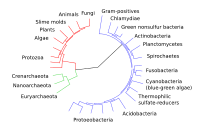 |
ในชีววิทยา คำว่า การปรับตัว (อังกฤษ: adaptation, adaptive trait) มีความหมาย 3 อย่างที่เกี่ยวข้องกัน คือ
- เป็นกระบวนการวิวัฒนาการแบบพลวัตที่ปรับประชากรสิ่งมีชีวิตให้เข้ากับสิ่งแวดล้อม และดังนั้น จึงเพิ่มความเหมาะสมของสิ่งมีชีวิต
- เป็นสภาพของกลุ่มประชากรเนื่องจากกระบวนการนั้น
- เป็นลักษณะปรากฏ/ฟีโนไทป์ หรือลักษณะการปรับตัว (adaptive trait) อย่างหนึ่งที่มีหน้าที่ในสิ่งมีชีวิตแต่ละหน่วย โดยกระบวนการคัดเลือกโดยธรรมชาติจะเป็นผู้รักษาและวิวัฒนาการ
สิ่งมีชีวิตทั้งหมดล้วนแต่เผชิญอุปสรรคในสิ่งแวดล้อมเมื่อพัฒนาเติบโตขึ้น และลักษณะสืบสายพันธุ์/ฟิโนไทป์ที่กำลังพัฒนาขึ้น ก็สามารถเปลี่ยนให้เข้ากับเงื่อนไขบังคับของสิ่งแวดล้อมได้ โดยเป็นสมรรถภาพที่เรียกว่า Phenotypic plasticity ซึ่งให้ความยืดหยุ่นได้กับสิ่งมีชีวิตในสภาพแวดล้อมต่าง ๆ
ประวัติ
การปรับตัวเป็นส่วนของชีวิต ที่นักปราชญ์ทั้งหลายผู้ขบปัญหาเรื่องโลกของสิ่งมีชีวิตได้ยอมรับ แม้จะอธิบายต่างกันว่า การปรับตัวเกิดขึ้นอย่างไร เอมเพโดคลีส (พ.ศ. 48-108) ไม่เชื่อว่า การปรับตัวต้องมีเป้าหมาย (a final cause) แต่ "เกิดโดยธรรมชาติ เพราะสิ่งเหล่านี้ได้รอดชีวิต" ส่วนอาริสโตเติล (พ.ศ. 160-222) ไม่เชื่อทั้งเป้าหมายและการปรับตัว แต่สมมุติว่าสปีชีส์ต่าง ๆ คงที่
ในสาขาเทววิทยาตามธรรมชาติ (natural theology) การปรับตัวเชื่อว่าเป็นงานของพระเป็นเจ้า เป็นแม้หลักฐานว่าพระเจ้ามีจริง[1] โดยบางท่านเชื่อว่า สิ่งมีชีวิตได้ปรับตัวอย่างสมบูรณ์แล้วกับชีวิตตามที่เป็นอยู่ หรือว่า พระเป็นเจ้าได้สร้างโลกขึ้นในสภาพดีที่สุดเท่าที่จะเป็นไปได้แล้ว นวนิยายสั้นของวอลแตร์ (พ.ศ. 2302) เป็นวรรณกรรมล้อแนวคิดมองโลกในแง่ดีเช่นนี้ [2] และเดวิด ฮูม (พ.ศ. 2254-2319) ก็ไม่เห็นด้วยว่าโลกมาจากการออกแบบ[3] ต่อมาชาลส์ ดาร์วิน (พ.ศ. 2415) จึงได้รื้อแนวคิดเช่นนี้โดยเน้นข้อบกพร่องและข้อจำกัดในพืชสัตว์ที่มีทั่วโลก[4]
ทฤษฎีของลามาร์กเป็นสมมติฐานก่อนทฤษฎีวิวัฒนาการเกี่ยวกับการสืบทอดลักษณะที่ได้ในช่วงชีวิต เพื่ออธิบายการปรับตัวซึ่งเกิดตามธรรมชาติ[5] คือนักธรรมชาติวิทยาชาวฝรั่งเศสลามาร์ก (พ.ศ. 2287-2372) ได้เสนอว่า สิ่งมีชีวิตโน้มเอียงที่จะมีความซับซ้อนมากขึ้น ก้าวหน้าขึ้น ที่ได้ "อิทธิพลจากสภาวะแวดล้อม" แล้วมักแสดงออกเป็น "การใช้หรือไม่ใช้"[6]
นักธรรมชาติวิทยาจำนวนมากได้ยอมรับการปรับตัว และบางคนก็ยอมรับวิวัฒนาการด้วย แต่ก็ไม่ได้ออกความเห็นถึงกลไกของพวกมัน จึงทำให้เห็นคุณค่าของแนวคิดจากดาร์วิน, อัลเฟรด รัสเซล วอลเลซ และนักวิชาการรองอื่น ๆ ผู้ได้เสนอกลไกที่ก่อนหน้านี้เห็นเพียงแค่วับ ๆ แวม ๆ ต่อมาอีกศตวรรษ งานศึกษาเชิงประสบการณ์ทั้งภาคสนามและภาคการทดลองด้วยการเพาะพันธุ์จึงได้แสดงหลักฐานว่า การคัดเลือกโดยธรรมชาติไม่ใช่เป็นเพียงแค่กลไกของการปรับตัวเท่านั้น เพราะมีอานุภาพยิ่งกว่าที่เคยคิดมาก่อน[7][8][9]
หลักทั่วไป
ความสำคัญของการปรับตัวสามารถเข้าใจได้ก็ต่อเมื่อสัมพันธ์กับสปีชีส์ที่มีอยู่ทั้งหมด
— จูเลียน ฮักซ์ลีย์, พ.ศ. 2485, Evolution: The Modern Synthesis[10]
การปรับตัวเป็นอะไร
การปรับตัวโดยหลักเป็น "กระบวนการ" แบบพลวัต ไม่ได้อยู่นิ่ง ๆ ไม่ได้เป็นเพียงแค่สัตว์หรืออวัยวะส่วนใดส่วนหนึ่ง[11] ปรสิตในร่างกาย (เช่น พยาธิใบไม้ในตับ) อาจช่วยให้เห็นได้ชัดขึ้น คือมันเป็นสัตว์ที่อาจมีโครงสร้างร่างกายที่ง่าย ๆ แต่ก็ได้ปรับตัวให้เข้ากับสิ่งแวดล้อมของมันโดยเฉพาะเป็นอย่างดี เราจะเห็นได้ว่า การปรับตัวไม่ใช่เพียงแค่ลักษณะปรากฏ เพราะการปรับตัวที่ขาดไม่ได้จำต้องเกิดในทั้งวัฏจักรชีวิต ซึ่งบ่อยครั้งค่อนข้างซับซ้อน[12]
แต่โดยเป็นคำที่ใช้ การปรับตัวบางครั้งยังหมายถึงผลที่ได้ คือลักษณะต่าง ๆ ของสปีชีส์ที่เป็นผลของกระบวนการนี้ แม้ลักษณะหลาย ๆ อย่างของพืชและสัตว์จะสามารถเรียกว่าเป็นการปรับตัวได้ แต่ก็มีลักษณะบางอย่างที่มีหน้าที่ไม่ชัดเจน ดังนั้น ถ้าแยกใช้คำว่า การปรับตัว (adaptation) โดยหมายถึงกระบวนการทางวิวัฒนาการ และ "ลักษณะปรับตัว" (adaptive trait) โดยหมายถึงอวัยวะหรือหน้าที่ของอวัยวะซึ่งเป็นผล เราก็อาจจะจำแนกความหมายหลักสองอย่างของคำนี้ได้[13][14][15][16]
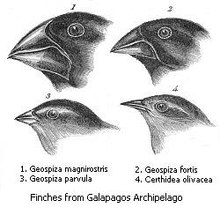
การปรับตัวเป็นกระบวนการหลักหนึ่งในสองอย่าง ที่อธิบายความหลากหลายของสปีชีส์ต่าง ๆ เช่นดังที่พบในนกจาบปีกอ่อนของดาร์วิน กระบวนการอีกอย่างก็คือการเกิดสปีชีส์ โดยปกติเนื่องจากการแยกสืบพันธุ์กัน (reproductive isolation)[17][18] ตัวอย่างที่มักใช้สำหรับอันตรกิริยาของการปรับตัวกับการเกิดสปีชีส์ ก็คือวิวัฒนาการของปลาหมอสีในทะเลสาบของแอฟริกา ที่การแยกสืบพันธุ์กันเป็นเรื่องซับซ้อน[19][20]
การปรับตัวไม่ใช่เป็นเพียงแค่วิวัฒนาการให้มีฟีโนไทป์ที่ดีที่สุดในสิ่งแวดล้อม เพราะสิ่งมีชีวิตต้องรอดชีวิตได้ในระยะพัฒนาการและวิวัฒนาการของมันทั้งหมด ซึ่งแสดงข้อจำกัดต่อวิวัฒนาการที่เป็นไปได้ทางพัฒนาการ, ทางพฤติกรรม, และทางโครงสร้างของสิ่งมีชีวิต
ข้อจำกัดหลัก แม้จะเป็นความเห็นที่ยังอภิปรายอย่างไม่ยุติ ก็คือความเปลี่ยนแปลงทางจีโนไทป์และฟีโนไทป์เนื่องจากวิวัฒนาการ ควรจะค่อนข้างน้อย เพราะพัฒนาการของระบบต่าง ๆ ของสิ่งมีชีวิตซับซ้อนและเกี่ยวเนื่องกันอย่างมาก แต่ก็ไม่ชัดเจนว่า "ค่อนข้างน้อย" นั้นแค่ไหน ตัวอย่างเช่น การเกิดมีโครโมโซมหลายชุด (polyploid) ในพืช เป็นการเปลี่ยนแปลงของยีนที่ใหญ่และค่อนข้างสามัญ[21] และการเกิดอยู่ร่วมกันของส่วนต่าง ๆ (symbiogenesis) ในยูแคริโอต ก็เป็นตัวอย่างที่น่าทึ่งยิ่งกว่านั้น[22]
การปรับตัวช่วยให้สิ่งมีชีวิตรอดชีวิตได้ในวิถีการดำรงชีวิตในนิเวศของตน (ecological niche)[23] ลักษณะปรับตัวอาจเป็นทางโครงสร้าง ทางพฤติกรรม หรือทางสรีรภาพ
การปรับตัวโดยโครงสร้างเป็นลักษณะทางกายของสิ่งมีชีวิต เช่นรูปร่าง เครื่องปกคลุมตัว อวัยวะที่ใช้เป็นอาวุธ อวัยวะภายใน เป็นต้น การปรับตัวโดยพฤติกรรมเป็นทั้งลูกโซ่พฤติกรรมที่สืบทอดมาและสมรรถภาพในการเรียนรู้ คือพฤติกรรมอย่างละเอียดอาจสืบทอดมาทั้งหมด (โดยเป็นสัญชาติญาณ) หรือเป็นสมรรถภาพในการเรียนรู้ที่สืบทอดมา ตัวอย่างการปรับตัวทางพฤติกรรมรวมทั้งการแสวงหาอาหาร การสืบพันธุ์ และการสื่อสาร ส่วนการปรับตัวทางสรีรภาพอาจทำให้ให้สิ่งมีชีวิตมีความสามารถพิเศษ เช่น สร้างพิษ (เช่นงู) หลั่งเมือก (เช่นหอยทาก) การเบนเพราะเหตุแสง (เช่นพืช) แต่ก็อาจจะเป็นสมรรถภาพทั่ว ๆ ไปเช่น การเจริญเติบโต การปรับอุณหภูมิกาย การควบคุมดุลยไอออน และด้านอื่น ๆ ของภาวะธำรงดุล การปรับตัวจะมีผลต่อชีวิตทุก ๆ ด้านของสิ่งมีชีวิต
นักชีววิทยาวิวัฒนาการชาวยูเครน-อเมริกันผู้ทรงอิทธิพล Theodosius Dobzhansky ได้ให้นิยามคำภาษาอังกฤษดังต่อไปนี้
- Adaptation (การปรับตัว) เป็นกระบวนการวิวัฒนาการที่สิ่งมีชีวิตสามารถอยู่ในที่อยู่อาศัยต่าง ๆ ของมันได้ดีขึ้น[24]
- Adaptedness (สภาพปรับตัวได้แล้ว) เป็นระดับที่สิ่งมีชีวิตสามารถรอดชีวิตและสืบพันธุ์ในที่อยู่อาศัยต่าง ๆ ของมัน[25]
- adaptive trait (ลักษณะการปรับตัว) เป็นรูปแบบพัฒนาการของสิ่งมีชีวิตที่เพิ่มโอกาสหรือทำให้สามารถอยู่รอดแล้วสืบพันธุ์[26]
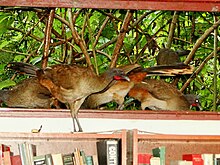
การปรับตัวไม่ใช่อะไร
การปรับตัวต่างจากความยืดหยุ่นได้ (flexibility) การปรับชินกับสิ่งแวดล้อม (acclimatization) และการเรียนรู้ ความยืดหยุ่นได้เป็นสมรรถภาพของสิ่งมีชีวิตที่จะดำรงตนอยู่ในที่อยู่อาศัยต่าง ๆ โดยขึ้นอยู่กับระดับการเป็นสิ่งมีชีวิตที่กินอยู่โดยเฉพาะ ๆ (generalist/specialist) การปรับชินกับสิ่งแวดล้อมเป็นการปรับเปลี่ยนทางสรีรภาพโดยอัตโนมัติในช่วงชีวิต ส่วนการเรียนรู้หมายถึงการปรับปรุงพฤติกรรมให้เหมาะสมมากขึ้นในระหว่างชีวิต คำเหล่านี้ใช้สำหรับการเปลี่ยนแปลงในชีวิตที่ไม่ได้สืบทอดไปยังรุ่นต่อไป
ความยืดหยุ่นได้มาจากความแปรผันได้ของฟีโนไทป์/ลักษณะปรากฏ (phenotypic plasticity) ซึ่งเป็นสมรรถภาพของสิ่งมีชีวิตพร้อมกับจีโนไทป์หนึ่ง ๆ ที่สามารถเปลี่ยนลักษณะปรากฏโดยตอบสนองต่อที่อยู่อาศัยหรือการย้ายไปอยู่ในที่แห่งใหม่[27][28] ระดับความยืดหยุ่นได้สืบทอดมาจากบรรพบุรุษ และต่างกันระหว่างสิ่งมีชีวิตแต่ละหน่วย
สัตว์และพืชที่ปรับตัวอย่างเฉพาะเจาะจง จะสามารถอยู่ในที่อยู่โดยเฉพาะ ๆ กินอาหารโดยเฉพาะ และไม่สามารถรอดชีวิตได้ถ้าไม่มีที่อยู่และอาหารตามที่จำเป็น สัตว์กินพืชหลายอย่างจะเป็นแบบนี้ ตัวอย่างสุด ๆ รวมทั้งหมีโคอาลาซึ่งต้องอาศัยยูคาลิปตัส และแพนด้ายักษ์ที่ต้องอาศัยไม้ไผ่ สัตว์ที่กินอยู่แบบทั่วไปจะสามารถกินอาหารได้หลายหลาก จึงรอดชีวิตได้ในสถานการณ์ต่าง ๆ ตัวอย่างรวมทั้งมนุษย์ หนู ปู และสัตว์กินเนื้อหลายอย่าง
ความโน้มเอียงที่จะประพฤติอย่างเฉพาะเจาะจงหรืออย่างตรวจสอบเรียนรู้ เป็นลักษณะที่สืบทอดทางพันธุกรรมและเป็นการปรับตัว ซึ่งต่างกับความยืดหยุ่นได้ทางพัฒนาการ ซึ่งก็คือ "สัตว์หรือพืชเรียกว่ายืดหยุ่นได้ทางพัฒนาการ ถ้าเมื่อโตขึ้นในหรือย้ายไปอยู่ในสถานการณ์ใหม่ มันเปลี่ยนโครงสร้างให้เหมาะสมขึ้นเพื่อรอดชีวิตในสิ่งแวดล้อมใหม่ได้"[29]
ถ้ามนุษย์ย้ายไปอยู่ในที่สูง การหายใจและการออกแรงจะเริ่มมีปัญหา แต่หลังจากผ่านไปสักระยะหนึ่งในที่สูง ก็จะปรับชินต่อระดับออกซิเจนที่ลดลง เช่น สร้างเม็ดเลือดแดงมากขึ้น สมรรถภาพในการปรับชินได้เช่นนี้ เป็นลักษณะการปรับตัวอย่างหนึ่ง แต่การปรับชินเองไม่ใช่ อนึ่ง ความสามารถในการมีบุตรก็จะลดลง และการตายจากโรคเขตร้อนบางอย่างก็จะลดลงด้วย แต่ในระยะเวลานาน บุคคลบางคนจะสามารถสืบพันธุ์ได้ดีกว่าคนอื่นในที่สูง ซึ่งทำให้มีลูกหลานมากกว่า และอย่างค่อยเป็นค่อยไปผ่านกระบวนการคัดเลือกโดยธรรมชาติ กลุ่มประชากรทั้งกลุ่มก็จะปรับตัวให้เข้ากับสิ่งแวดล้อมใหม่ นี่เป็นเรื่องที่ได้เกิดขึ้นจริง ๆ และสมรรถภาพของกลุ่มประชากรที่อยู่มานานในที่สูง ก็จะดีกว่าผู้ที่ย้ายมาอยู่ใหม่อย่างสำคัญ แม้เมื่อคนใหม่อาจปรับชินแล้ว[30]
สภาพปรับตัวได้แล้วและความเหมาะสม
ในพันธุศาสตร์ประชากร สภาพปรับตัวได้แล้วสัมพันธ์กับความเหมาะสม ความแตกต่างของความเหมาะสมระหว่างจีโนไทป์ สามารถพยากรณ์อัตราวิวัฒนาการผ่านการคัดเลือกโดยธรรมชาติ คือการคัดเลือกโดยธรรมชาติจะเปลี่ยนความถี่ของฟีโนไทป์รูปแบบต่าง ๆ โดยจะเป็นไปตามระดับที่มันสามารถสืบทอดต่อไปได้[31] แต่ฟีโนไทป์ที่ปรับตัวได้แล้วในระดับสูงก็อาจไม่มีความเหมาะสมที่ดี Dobzhansky ได้กล่าวถึงสนแดงแคลิฟอร์เนีย (Sequoia sempervirens) ซึ่งปรับตัวเข้ากับสิ่งแวดล้อมได้เป็นอย่างดี แต่เป็นสปีชีส์ที่เสี่ยงต่อการสูญพันธุ์[24]
นักปรัชญาท่านหนึ่งให้ข้อสังเกตว่า สภาพปรับตัวได้แล้วเป็นแนวคิดแบบมองย้อนหลัง เพราะมันกล่าวอะไรบางอย่างเกี่ยวกับประวัติของลักษณะปรากฏอย่างหนึ่ง เทียบกับความเหมาะสมที่พยากรณ์อนาคตของลักษณะปรากฏ[32]
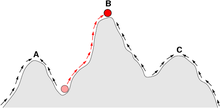
นิยามของความเหมาะสมและสภาพปรับตัวได้แล้วต่างกันดังนี้คือ
- ความเหมาะสมเปรียบเทียบ (Relative fitness) เป็นการให้จีโนไทป์หรือกลุ่มจีโนไทป์โดยเฉลี่ยกับสิ่งมีชีวิตรุ่นต่อไป เทียบกับจีโนไทป์อื่น ๆ ทั้งหมดในกลุ่มประชากร[33] ซึ่งเรียกได้ด้วยว่า Darwinian fitness (ความเหมาะสมแบบดาร์วิน), selection coefficient (สัมประสิทธิ์การคัดเลือก) เป็นต้น
- ความเหมาะสมสัมบูรณ์ (Absolute fitness) เป็นการให้จีโนไทป์หรือกลุ่มจีโนไทป์แก่รุ่นต่อไปโดยสัมบูรณ์ ซึ่งก็เรียกได้ด้วยว่า Malthusian parameter (ตัวแปรเสริมมาลธัส) เมื่อประยุกต์ใช้กับกลุ่มประชากรทั้งหมด[31][34] กล่าวอีกอย่างก็คือ ความเหมาะสมสัมบูรณ์ของจีโนไทป์หนึ่ง เป็นความเปลี่ยนแปลงตามสัดส่วนของความมากน้อยของจีโนไทป์นั้น ๆ ในสิ่งมีชีวิตรุ่นหนึ่งที่มีเหตุจากการคัดเลือก
- สภาพปรับตัวได้แล้ว (Adaptedness) คือระดับที่ฟีโนไทป์หนึ่ง ๆ เหมาะกับวิถีชีวิตทางนิเวศของสิ่งมีชีวิต นักวิจัยบางครั้งสามารถตรวจสอบสภาพนี้ได้ด้วยการทดลองการปลูกถ่ายกลับกันและกัน (reciprocal transplant) คือปลูกพืชในสิ่งแวดล้อมที่มันเคยชิน แล้วย้ายที่ไปในถิ่นของกันและกัน
ดร. ซีวอลล์ ไรท์ ผู้ก่อตั้งสาขาพันธุศาสตร์ประชากร ได้เสนอว่า กลุ่มประชากรต่าง ๆ จะอยู่ที่ "ยอดการปรับตัว" ต่าง ๆ ในภูมิภาคความเหมาะสม (fitness landscape) และเพื่อจะวิวัฒนาการไปสู่ยอดที่สูงกว่า กลุ่มประชากรจะต้องผ่าน "หุบเขา" ที่เป็นสภาพในระหว่างที่ปรับตัวได้ไม่ดี (maladaptive)[35] โดยกลุ่มประชากรหนึ่ง ๆ อาจจะติดอยู่ที่ยอดซึ่งไม่ใช่เป็นการปรับตัวดีสุด
มูลฐานทางพันธุกรรม
ความหลากหลายของดีเอ็นเอในจีโนมของสปีชีส์หนึ่ง ๆ เป็นมูลฐานของการปรับตัวและความแตกต่าง และกลุ่มประชากรที่ใหญ่ก็จำเป็นเพื่อให้มีความหลากหลายเพียงพอ
ประเภท
การปรับตัวเป็นหัวใจและวิญญาณของกระบวนการวิวัฒนาการ
— Niles Eldredge, พ.ศ. 2538[36]
การเปลี่ยนที่อยู่
ก่อนดาร์วิน การปรับตัวมองว่าเป็นความสัมพันธ์ที่ตายตัวระหว่างสิ่งมีชีวิตกับที่อยู่อาศัย คือยังไม่เข้าใจว่า เมื่อภูมิอากาศเปลี่ยน ที่อยู่อาศัยก็จะเปลี่ยนตามไปด้วย และเมื่อที่อยู่อาศัยเปลี่ยน ชีวชาติก็จะเปลี่ยนไปด้วย อนึ่ง แม้ที่อยู่อาศัยก็อาจเปลี่ยนไปตามชีวชาติด้วย ยกตัวอย่างเช่น สิ่งมีชีวิตซึ่งมาจากที่อื่นแล้วทำลายสิ่งมีชีวิตในอีกเขตหนึ่ง และจำนวนสปีชีส์ซึ่งอยู่ในที่อยู่อาศัยหนึ่ง ๆ ก็ยังเปลี่ยนแปลงอยู่ตลอดเวลาอีกด้วย ดังนั้น ความเปลี่ยนแปลงจึงเป็นเรื่องธรรมดา แม้ความรวดเร็วและระดับการเปลี่ยนแปลงจะต่างกันบ้าง
เมื่อที่อยู่อาศัยเปลี่ยนไป สิ่งมีชีวิต ณ ที่นั้นจะเปลี่ยนแปลงโดย 3 วิธี คือ หาที่อยู่ใหม่ (habitat tracking) เปลี่ยนยีน หรือสูญพันธุ์ และจริง ๆ แล้ว ทั้งสามอย่างอาจเกิดตามลำดับ ในบรรดาปรากฏการณ์เหล่านี้ การเปลี่ยนยีนเท่านั้นทำให้ปรับตัวได้ เมื่อที่อยู่เปลี่ยนไป สิ่งมีชีวิตปกติจะย้ายไปอยู่ที่อื่นซึ่งเหมาะกว่า เช่นปกติที่พบในแมลงที่บินได้หรือสิ่งมีชีวิตในทะเล ที่สามารถย้ายไปได้ไกล ๆ แม้จะมีจุดจำกัด[37] ปรากฏการณ์สามัญนี้เรียกว่า การหาที่อยู่ใหม่ (habitat tracking) ซึ่งเป็นคำอธิบายหนึ่งว่า ทำไมบันทึกซากดึกดำบรรพ์ในบางช่วงจึงดูเหมือนจะหยุดนิ่ง คือไม่เกิดวิวัฒนาการใหม่ ๆ (เช่นในทฤษฎีดุลยภาพเป็นพัก ๆ [punctuated equilibrium])[38]
การเปลี่ยนแปลงของยีน
การเปลี่ยนแปลงของยีนจะเกิดในกลุ่มประชากร เมื่อการคัดเลือกโดยธรรมชาติและการกลายพันธุ์ออกฤทธิ์ต่อความผันแปรได้ทางพันธุกรรมของกลุ่ม[39] โดยวิธีการนี้ กลุ่มประชากรจึงปรับตัวให้เข้ากับสถานการณ์ได้[9] การเปลี่ยนยีนอาจมีผลเป็นโครงสร้างที่มองเห็นได้ หรืออาจปรับการทำงานทางสรีรภาพซึ่งเหมาะกับที่อยู่อาศัย
ที่อยู่อาศัยและชีวชาติมักจะเปลี่ยนบ่อย ๆ ดังนั้น กระบวนการปรับตัวจึงไม่เคยยุติ[40] ในระยะยาว อาจเป็นไปได้ที่สิ่งแวดล้อมจะเปลี่ยนน้อยมาก และดังนั้น สปีชีส์ต่าง ๆ จึงปรับตัวให้เหมาะสมเข้ากับสิ่งแวดล้อมได้ดีขึ้นเรื่อย ๆ โดยนัยตรงกันข้าม ก็อาจเป็นไปได้ว่าสิ่งแวดล้อมอาจเปลี่ยนไปอย่างรวดเร็ว และดังนั้น สปีชีส์ต่าง ๆ จึงมีการปรับตัวที่แย่ลงเรื่อย ๆ จากมุมมองนี้ การปรับตัวเป็นกระบวนการสะกดรอยของยีน ซึ่งเป็นไปอยู่ตลอดเวลาในระดับหนึ่ง แต่โดยเฉพาะเมื่อกลุ่มประชากรไม่สามารถ หรือไม่ย้ายไปในที่อยู่อื่นซึ่งมีอุปสรรคน้อยกว่า ถ้ายีนเปลี่ยนไปอย่างเพียงพอ และมีสภาพทางประชากรบางอย่าง การปรับตัวอย่างหนึ่งอาจพอให้กลุ่มประชากรรอดจากการสูญพันธุ์ ควรจะสังเกตว่า การปรับตัวมีอิทธิพลต่อทุกสปีชีส์ในระบบนิเวศหนึ่ง ๆ ในระดับต่าง ๆ[41][42]
นักชีววิทยาวิวัฒนาการชาวอเมริกัน ดร. เล แวน แวเล็น (Leigh Van Valen) เชื่อว่า แม้ในสิ่งแวดล้อมที่เสถียร สปีชีส์ที่แข่งขันกันก็ยังต้องปรับตัวเสมอ ๆ เพื่อให้คงอยู่ที่จุดยืนเดิม เป็นสมมติฐานซึ่งต่อมาเรียกว่า Red Queen hypothesis ดังที่เห็นตัวอย่างในปฏิสัมพันธ์ระหว่างปรสิต-ผู้ถูกเบียน[43]

การปรับตัวร่วมกัน (Co-adaptation)
ในวิวัฒนาการร่วมกันที่สปีชีส์หนึ่งมีชีวิตผูกพันอยู่กับอีกสปีชีส์อื่น การปรับตัวใหม่ ๆ ของสปีชีส์หนึ่งก็จะตามด้วยการเกิดหรือการขยายตัวของลักษณะที่คู่กันของสปีชีส์อื่น ๆ ความสัมพันธ์เช่นนี้จะเป็นแบบพลวัตโดยธรรมชาติ และอาจดำเนินเป็นล้าน ๆ ปี ดังที่เกิดในความสัมพันธ์ระหว่างพืชดอกกับแมลงที่เป็นพาหะถ่ายละอองเรณู
การเลียนแบบ (Mimicry)
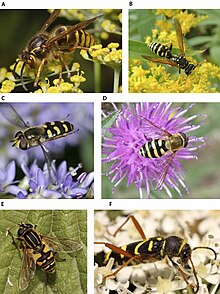
งานของนักธรรมชาติวิทยาชาวอังกฤษเฮ็นรี่ วอลเตอร์ เบตส์ กับผีเสื้อเขตแอมะซอนทำให้เขาค้นพบปรากฏการณ์เลียนแบบ (mimicry) เป็นครั้งแรกทางวิทยาศาสตร์ โดยเฉพาะประเภทที่ต่อมาเรียกว่า Batesian mimicry[44] ซึ่งสปีชีส์ที่อร่อยเลียนแบบให้ดูเหมือนกับสปีชีส์ที่ไม่อร่อยหรือเป็นอันตราย ตัวอย่างสามัญในสวนเขตอบอุ่นก็คือ แมลงวันตอมดอกไม้ ซึ่งหลายอย่างแม้จะไม่มีเหล็กใน แต่ก็เลียนสีของต่อ เป็นการเลียนแบบที่ไม่จำเป็นต้องสมบูรณ์เพื่อเพิ่มอัตรารอดชีวิตของสปีชีส์ที่อร่อย[45]
เบตส์, อัลเฟร็ด วอลเลซ, และฟริตซ์ มิวเลอร์ เชื่อว่าการเลียนแบบทั้งแบบ Batesian และแบบ Müllerian เป็นหลักฐานของกระบวนการคัดเลือกโดยธรรมชาติ และนี่ก็เป็นมุมมองมาตรฐานของนักชีววิทยาปัจจุบัน[46] งานทั้งในสนามและโดยการทดลองเกี่ยวกับเรื่องเหล่านี้ก็ยังดำเนินมาจนถึงทุกวันนี้ โดยเชื่อมกับการเกิดสปีชีส์ พันธุศาสตร์ และชีววิทยาพัฒนาการเชิงวิวัฒนาการ (evolutionary developmental biology)[47]
ข้อดีข้อเสีย
เป็นความจริงที่ล้ำลึกว่าธรรมชาติไม่ได้รู้ดีที่สุด ว่าวิวัฒนาการทั่วไปเป็นเรื่องสิ้นเปลือง ทำชั่วครั้งชั่วคราว การอะลุ้มอล่วย และความผิดพลาด
— Peter Medawar, นักชีววิทยาชาวอังกฤษผู้เป็น "บิดา" ของการปลูกถ่ายอวัยวะ[48]
การปรับตัวทุกอย่างมีข้อเสีย เช่น ขาม้าดีมากสำหรับวิ่งบนหญ้า แต่ม้าไม่สามารถเกาหลังของตัวเอง ขนของสัตว์เลี้ยงลูกด้วยนมช่วยรักษาอุณหภูมิ แต่ก็เป็นที่อยู่ของปรสิตภายนอก เพนกวินก็สามารถบินได้ใต้น้ำเท่านั้น ลักษณะการปรับตัวอาจทำหน้าที่ต่าง ๆ แต่ขัดแย้งกัน การปรับตัวแบบอะลุ้มอล่วยและทำชั่วครั้งชั่วคราวเกิดอย่างกว้างขวาง ไม่ใช่อะไรที่สมบูรณ์ เพราะการคัดเลือกจะกดดันจากหลาย ๆ ทิศ ดังนั้น การปรับตัวที่เป็นผลจึงเป็นแบบอะลุ้มอล่วย[49]
เพราะฟีโนไทป์ทั้งหมดเป็นเป้าหมายของการคัดเลือก มันจึงเป็นไปไม่ได้ที่จะทำทุกด้าน ๆ ของฟีโนไทป์ให้ดีขึ้นโดยเท่า ๆ กัน
— Ernst Mayr[50]
ลองพิจารณาเขาของกวางไอริชที่สูญพันธุ์ไปแล้ว (ซึ่งสมมุติบ่อย ๆ ว่าใหญ่เกิน เพราะในกวาง ขนาดเขาจะสัมพันธ์กับขนาดร่างกายในเชิงอัลโลเมตริก) ชัดเจนว่า กวางใช้เขาเพื่อป้องกันสัตว์ล่าเยื่อ และเพื่อชัยชนะในฤดูผสมพันธุ์ แต่มันก็ค่อนข้างแพงในด้านทรัพยากร ขนาดของเขากวางในยุคน้ำแข็งสุดท้าย จึงขึ้นอยู่กับสมรรถภาพการสืบพันธุ์ที่ได้เทียบกับเสียในกลุ่มประชากรกวางในยุคนั้น[51] อีกตัวอย่างก็คือ การพรางตัวที่ช่วยให้สัตว์อื่นมองไม่เห็น จะใช้งานไม่ได้เมื่อแสดงสีที่สวยงามระหว่างการหาคู่ ในช่วงนี้ ความเสี่ยงต่อชีวิตจะถ่วงดุลกับความจำเป็นในการสืบพันธุ์
ซาลาแมนเดอร์แท้ยุโรปที่อยู่ในธารน้ำ เช่นพันธุ์ Mertensiella caucasica (Caucasian salamander) หรือ Chioglossa lusitanica (Gold-striped salamander) มีตัวผอมยาวที่ปรับตัวเข้ากับชีวิตบนฝั่งแม่น้ำเล็ก ๆ ที่ไหลอย่างรวดเร็วหรือในลำธารในภูเขา เพราะความยาวของตัวป้องกันไม่ให้ตัวอ่อนถูกพัดไปกับน้ำ แต่ก็เสี่ยงต่อผิวแห้งยิ่งขึ้นและลดสมรรถภาพการกระจายพันธุ์ของซาลาแมนเดอร์ และยังมีผลต่อสมรรถภาพในการมีลูกของมันอีกด้วย และดังนั้น ซาลาแมนเดอร์อีกพันธุ์หนึ่งคือ Salamandra salamandra (fire salamander) ซึ่งปรับตัวเข้ากับลำธารในภูเขาได้น้อยกว่า จึงประสบความสำเร็จในการกระจายพันธุ์มากกว่าโดยทั่วไป คือมีลูกดกกว่าและมีพิสัยที่อยู่ที่กว้างกว่า[52]
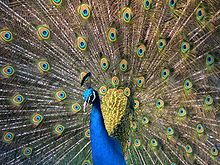
หางนกยูงอินเดียเป็นเครื่องประดับที่เกิดใหม่ทุก ๆ ฤดูผสมพันธุ์ เป็นการปรับตัวที่รู้จักกันดีอย่างหนึ่ง มันทำให้นกยูงตัวผู้ขยับตัวและบินได้ไม่คล่อง ทำให้เห็นตัวได้ชัด และการออกขนใหม่ก็ต้องอาศัยอาหาร ดาร์วินใช้การคัดเลือกทางเพศเป็นเครื่องอธิบายประโยชน์ของขน "นี่ขึ้นอยู่กับความได้เปรียบที่สิ่งมีชีวิตแต่ละหน่วยมีเหนือกว่าหน่วยอื่น ๆ เพศเดียวกันและสปีชีส์เดียวกัน เป็นเรื่องของการสืบพันธุ์โดยเฉพาะ"[53] การคัดเลือกทางเพศเช่นนี้ที่เห็นในนกยูงเรียกว่า "mate choice" ซึ่งแสดงนัยว่า กระบวนการนี้เลือกนกตัวที่เหมาะสมกว่า และดังนั้น จึงมีคุณค่าในการรอดชีวิต[54] แต่ทฤษฎีนี้ในปัจจุบันก็ได้เปลี่ยนไปบ้างแล้ว[55]
ความขัดแย้งระหว่างขนาดสมองของทารกมนุษย์เมื่อคลอด (ซึ่งไม่สามารถใหญ่กว่าประมาณ 400 ซม3 ไม่เช่นนั้นก็จะผ่านเชิงกรานของแม่ออกมาไม่ได้) กับขนาดสมองของผู้ใหญ่ (เฉลี่ยที่ 1,300 ซม3) หมายความว่า สมองของทารกเกิดใหม่ยังต้องเจริญเติบโตอีกมาก สิ่งที่จำเป็นต่อชีวิตมนุษย์มากที่สุด (รวมทั้งการเคลื่อนไหวและการพูด) จำต้องรอให้สมองโตเสียก่อน นี่เป็นผลของการอะลุ้มอล่วยในกำเนิดทารก เป็นปัญหาที่โดยมากมาจากการเป็นสัตว์สองเท้าของมนุษย์ เพราะถ้าไม่ได้เดินด้วยสองเท้า เชิงกรานแม่ก็อาจจะมีรูปร่างที่เหมาะสมกับศีรษะที่ใหญ่ยิ่งกว่านี้ นี่เป็นปัญหาที่สายพันธุ์มนุษย์ที่มีสมองใหญ่เช่นนีแอนเดอร์ทาลก็มีเหมือนกัน[56][57][58]
อีกตัวอย่างหนึ่งก็คือ คอยาวของยีราฟเป็นทั้งภาระและข้อได้เปรียบ คอยีราฟอาจยาวถึง 2 เมตร[59] ซึ่งสามารถใช้สู้กับยีราฟอื่น ๆ หรือใช้หาอาหารบนต้นไม้สูงที่สัตว์กินพืชอื่นไม่สามารถเอื้อมถึง แต่ก็เหมือนดังที่กล่าวมาก่อน ข้อเสียก็มีด้วย คือคอยาวจึงหนัก ซึ่งเพิ่มมวลร่างกายของยีราฟ จึงจำเป็นต้องได้อาหารมากเพื่อจะได้ลักษณะปรับตัวที่มีราคาแพงเช่นนี้[60]
การเปลี่ยนหน้าที่
การปรับตัวและหน้าที่เป็นหน้า 2 หน้าของปัญหาเดียวกัน
— จูเลียน ฮักซ์ลีย์[61]
การปรับตัวล่วงหน้า
การปรับตัวล่วงหน้า (Pre-adaptation) จะเกิดเมื่อสปีชีส์หรือกลุ่มประชากรหนึ่ง ๆ บังเอิญมีลักษณะที่เหมาะสมกับสิ่งแวดล้อมซึ่งยังไม่เกิดขึ้น ยกตัวอย่างเช่น หญ้า Spartina townsendii (cordgrass) ปรับตัวเข้ากับที่ลุ่มชื้นแฉะและโคลนชายฝั่งใกล้ทะเล ได้ดีกว่าสปีชีส์ที่เป็นบรรพบุรุษทั้งสอง[62] ไก่เล็กฮอน (Leghorn) สีขาวมีปัญหาเกี่ยวกับการขาดวิตามินบี1น้อยกว่าพันธุ์อื่น ๆ[63] เมื่อมีอาหารมาก นี่ไม่ได้ช่วยอะไร แต่ถ้ามีอาหารน้อย การปรับตัวโดยบังเอิญเช่นนี้อาจเป็นความได้เปรียบที่ชี้ขาด
การปรับตัวล่วงหน้าอาจเกิดขึ้นเพราะกลุ่มประชากรตามธรรมชาติมีความแตกต่างทางพันธุกรรมที่สูงมาก[64] ในยูแคริโอตแบบมีโครโมโซมสองชุด นี่เป็นผลจากระบบการสืบพันธุ์แบบอาศัยเพศ ที่อัลลีลซึ่งกลายพันธุ์ได้การป้องกันเป็นบางส่วน จุลินทรีย์ที่มีประชากรมหาศาล ก็จะมีความแตกต่างทางพันธุกรรมที่สูงยิ่ง
หลักฐานทางการทดลองแรกเกี่ยวกับการปรับตัวล่วงหน้าในจุลินทรีย์มาจากการทดสอบ "Fluctuation Test" ในการทดลอง "Luria-Delbrück experiment" เป็นวิธีที่แสดงว่า ความผันแปรโดยบังเอิญของการเปลี่ยนแปลงของยีนที่มีอยู่แล้ว สามารถให้ภูมิต้านทานต่อต้านไวรัสทำลายแบคทีเรีย (bacteriophage) กับแบคทีเรีย Escherichia coli ได้

การประยุกต์ใช้ลักษณะที่มี (exaptation)
ตัวอย่างคลาสสิกของการประยุกต์ใช้ส่วนที่มีก็คือกระดูกหูของสัตว์เลี้ยงลูกด้วยนม ซึ่งเรารู้จากการศึกษาทางบรรพชีวินวิทยาและคัพภวิทยาว่า มาจากกระดูกขากรรไกรบนและล่างที่มีในสัตว์บรรพบุรุษประเภท Synapsid โดยในบรรพบุรุษปลาก่อนหน้านั้นเป็นส่วนของแกนกระดูกเหงือก (Branchial arch)[65]
ความรู้ที่ลี้ลับนี้มาจากนักกายวิภาคศาสตร์เชิงเปรียบเทียบ ผู้เมื่อหนึ่งศตวรรษก่อน ได้ทำการศึกษาทางวิวัฒนาการที่ก้าวหน้าที่สุด[66] และได้บัญญัติคำว่า exaptation โดยหมายถึงการเปลี่ยนหน้าที่ของโครงสร้าง ซึ่งเป็นเรื่องสามัญอย่างน่าอัศจรรย์ในประวัติวิวัฒนาการ[67] ส่วนกำเนิดปีกจากขนนกที่เบื้องต้นใช้เพื่อกันหนาว เช่นที่พบในไดโนเสาร์ Sinosauropteryx เป็นสิ่งที่เพิ่งค้นพบเมื่อไม่นานนี้
ลักษณะที่ไม่ปรับตัว
ลักษณะปรากฏบางอย่างดูจะไม่ใช่การปรับตัว ซึ่งก็คือ มันมีผลเป็นกลางหรือมีผลร้ายต่อความเหมาะสมกับสิ่งแวดล้อมปัจจุบัน เพราะยีนมีผลต่อฟีโนไทป์หลายอย่าง (เป็น pleiotropic) ดังนั้น ลักษณะปรากฏบางอย่างอาจไม่มีประโยชน์อะไร นี่อาจเป็นสิ่งที่นักวิชาการชาวอเมริกันคู่หนึ่ง (Stephen Jay Gould และ Richard Lewontin) เรียกว่า "spandrel" ซึ่งหมายถึงลักษณะที่เกิดเพราะการปรับตัวของลักษณะที่อยู่ใกล้ ๆ กัน[68]
อนึ่ง ลักษณะบางอย่างอาจเป็นการปรับตัวในอดีต แต่การเปลี่ยนแปลงของที่อยู่อาศัยเป็นเหตุทำลักษณะปรับตัวให้ไม่จำเป็นและแม้แต่กลายเป็นอุปสรรค (maladaptation) ลักษณะปรับตัวเช่นนี้เรียกว่าเป็นลักษณะเหลือค้าง (vestigial) สิ่งมีชีวิตจำนวนมากมีอวัยวะเหลือค้าง ซึ่งเป็นส่วนเหลือของโครงสร้างที่มีประโยชน์ในบรรพบุรุษ แต่เนื่องจากความเปลี่ยนแปลงในวิถีชีวิต อวัยวะนั้นจึงกลายเป็นไม่จำเป็น และใช้งานไม่ได้หรือใช้งานได้ลดลง แต่เพราะโครงสร้างทุกอย่างมีราคาต่อร่างกาย เพราะฉะนั้น การกำจัดสิ่งที่ใช้การไม่ได้จึงอาจมีประโยชน์ ยกตัวอย่างเช่น ฟันกรามซี่สุดท้ายในมนุษย์ การเสียการเห็นเป็นสีหรือแม้แต่การเห็นโดยสิ้นเชิงของสัตว์ในถ้ำ การเสียอวัยวะภายในต่าง ๆ ของปรสิตภายใน[69]
การสูญพันธุ์และการสูญพันธุ์ร่วมกัน
ถ้ากลุ่มประชากรไม่สามารถย้ายที่หรือเปลี่ยนพอที่จะรอดชีวิตได้ในระยะยาว ชัดเจนว่ามันก็จะสูญพันธุ์ไปอย่างน้อยก็ในพื้นที่นั้น ๆ และในพื้นที่อื่น ๆ สปีชีส์นั้นอาจจะรอดชีวิตหรือไม่รอด การสูญพันธุ์ระดับสปีชีส์จะเกิดขึ้นเมื่ออัตราการตายของสปีชีส์ทั้งหมด เกินอัตราการเกิดเป็นระยะเวลานานพอที่สิ่งมีชีวิตจะหายสาบสูญไป ดร. แวเล็นเองได้ให้ข้อสังเกตว่า สปีชีส์เป็นกลุ่ม ๆ มักจะมีอัตราการสูญพันธุ์ที่เฉพาะเจาะจงและสม่ำเสมอ[70]
เหมือนกับการปรับตัวร่วมกัน ก็มีการสูญพันธุ์ร่วมกันด้วย[71] การสูญพันธุ์ร่วมกันเป็นการหายสาบสูญของสปีชีส์เนื่องจากการสูญพันธุ์ของอีกสปีชีส์หนึ่งที่ได้ปรับตัวร่วมกัน เหมือนกับการสูญพันธุ์ของปรสิตเมื่อตัวถูกเบียนสูญพันธุ์ หรือเมื่อพืชมีดอกสูญพันธุ์เนื่องจากพาหะถ่ายละอองของมันสาบสูญ หรือเมื่อโซ่อาหารเสียระบบ[72]
ปัญหาทางปรัชญา
เมื่อนักชีววิทยากล่าวถึงหน้าที่และจุดประสงค์ของการปรับตัว นี่จะสร้างปัญหาทางปรัชญาเพราะเป็นการแสดงนัยว่า ลักษณะอย่างหนึ่งวิวัฒนาการขึ้นผ่านการคัดเลือกโดยธรรมชาติเพื่อจุดประสงค์อย่างหนึ่ง ที่อาจมาจากการแทรกแซงเหนือธรรมชาติ ซึ่งก็คือลักษณะและสิ่งมีชีวิตต่าง ๆ เกิดเพราะเจตจำนงของเทพเจ้า[73][74] อาริสโตเติลได้อ้างว่า สภาพปรับตัวได้ของสิ่งมีชีวิตมีจุดมุ่งหมาย (teleological) แต่ไม่ยอมรับเจตจำนงเหนือธรรมชาติตามแนวคิดของเพลโต[75][76]
แม้นักชีววิทยาก็ยังมีปัญหาเดียวกันในปัจจุบัน[77][78][79][80][81][82] คือในด้านหนึ่ง การปรับตัวดูเหมือนจะมีจุดมุ่งหมาย เพราะการคัดเลือกโดยธรรมชาติ "เลือก" สิ่งที่ใช้การได้และ "กำจัด" สิ่งที่ใช้การไม่ได้ ส่วนในอีกด้านหนึ่ง นักชีววิทยาก็ปฏิเสธจุดมุ่งหมายแบบตั้งใจในกระบวนการวิวัฒนาการ
ทางเลือกทวิบทเช่นนี้ทำให้นักชีววิทยาวิวัฒนาการชาวอินเดีย-อังกฤษฮอลเดน (J. B. S. Haldane) ได้พูดตลกไว้ว่า "การมีเป้าหมาย (Teleology) เป็นเหมือนกับเมียน้อยของนักชีววิทยา เพราะเขาไม่สามารถอยู่ได้โดยไม่มีเธอ แต่เขาก็ไม่เต็มใจที่จะให้เห็นพร้อมกับเธอต่อหน้าธารกำนัล" ส่วนนักปรัชญาชีววิทยาชาวอเมริกันเดวิด ฮัลล์ ได้แสดงข้อคิดเห็นว่า เมียน้อยของฮอลเดน "ได้กลายเป็นภรรยาที่ได้แต่งงานอย่างถูกกฎหมายแล้ว (เพราะ) นักชีววิทยาไม่รู้สึกจำต้องขอโทษการใช้ภาษาแบบแสดงจุดมุ่งหมายอีกต่อไป แต่กลับอวดมัน"[83]
เชิงอรรถและอ้างอิง
- ↑ Desmond 1989, pp. 31–32, fn 18
- ↑ Voltaire 1759
- ↑ Sober 1993, chpt. 2
- ↑ Darwin 1872, p. 397: "Rudimentary, Atrophied, and Aborted Organs"
- ↑ See, for example, the discussion in Bowler 2003, pp. 86–95: "Whatever the true nature of Lamark's theory, it was his mechanism of adaptation that caught the attention of later naturalists." (p. 90)
- ↑ Bowler, Peter J. (1989) [1983]. Evolution The History of an Idea (Revised ed.). University of California Press. p. 86. ISBN 0-520-06386-4.
- ↑ Provine 1986
- ↑ Ford 1975
- ↑ 9.0 9.1
Orr, H. Allen (2005-02). "The genetic theory of adaptation: a brief history". Nature Reviews Genetics. London: Nature Publishing Group. 6 (2): 119–127. doi:10.1038/nrg1523. ISSN 1471-0056. PMID 15716908.
{{cite journal}}: ตรวจสอบค่าวันที่ใน:|date=(help) - ↑ Huxley 1942, p. 449
- ↑ Mayr 1982, p. 483: "Adaptation... could no longer be considered a static condition, a product of a creative past, and became instead a continuing dynamic process."
- ↑ Price 1980
- ↑
Daintith, John; Martin, Elizabeth A., บ.ก. (2010) [First published 1984 as Concise Science Dictionary]. "adaptation". A Dictionary of Science. Oxford Paperback Reference (6th ed.). Oxford; New York: Oxford University Press. p. 13. ISBN 978-0-19-956146-9. LCCN 2010287468. OCLC 444383696.
Any change in the structure or functioning of successive generations of a population that makes it better suited to its environment.
- ↑ Bowler 2003, p. 10
- ↑ Patterson 1999, p. 1
- ↑ Williams 1966, p. 5: "Evolutionary adaptation is a phenomenon of pervasive importance in biology."
- ↑ Mayr 1963
- ↑ Mayr 1982, pp. 562–566
- ↑ Salzburger, Walter; Mack, Tanja; Verheyen, Erik; Meyer, Axel (2005-02-21). "Out of Tanganyika: Genesis, explosive speciation, key-innovations and phylogeography of the haplochromine cichlid fishes" (PDF). BMC Evolutionary Biology. London: BioMed Central. 5 (17). doi:10.1186/1471-2148-5-17. ISSN 1471-2148. PMC 554777. PMID 15723698. สืบค้นเมื่อ 2015-08-15.
- ↑
Kornfield, Irv; Smith, Peter F. (2000-11). "African Cichlid Fishes: Model Systems for Evolutionary Biology". Annual Review of Ecology and Systematics. Palo Alto, CA: Annual Reviews. 31: 163–196. doi:10.1146/annurev.ecolsys.31.1.163. ISSN 1545-2069.
{{cite journal}}: ตรวจสอบค่าวันที่ใน:|date=(help) - ↑ Stebbins 1950, chpts. 8 and 9
- ↑ Margulis & Fester 1991
- ↑ Hutchinson 1965. The niche is the central concept in evolutionary ecology; see especially part II: "The niche: an abstractly inhabited hypervolume." (pp. 26-78)
- ↑ 24.0 24.1 Dobzhansky 1968, pp. 1–34
- ↑ Dobzhansky 1970, pp. 4–6, 79–82
- ↑ Dobzhansky, Theodosius (1956-03). "Genetics of Natural Populations. XXV. Genetic Changes in Populations of Drosophila pseudoobscura and Drosophila persimilis in Some Localities in California". Evolution. Hoboken, NJ: John Wiley & Sons for the Society for the Study of Evolution. 10 (1): 82–92. doi:10.2307/2406099. JSTOR 2406099.
{{cite journal}}: ตรวจสอบค่าวันที่ใน:|date=(help) - ↑
Price, Trevor D.; Qvarnström, Anna; Irwin, Darren E. (2003-07). "The role of phenotypic plasticity in driving genetic evolution". Proceedings of the Royal Society B. London: Royal Society. 270 (1523): 1433–1440. doi:10.1098/rspb.2003.2372. ISSN 0962-8452. PMC 1691402. PMID 12965006.
{{cite journal}}: ตรวจสอบค่าวันที่ใน:|date=(help) - ↑
Price, Trevor D. (2006-06). "Phenotypic plasticity, sexual selection and the evolution of colour patterns". The Journal of Experimental Biology. Cambridge, UK: The Company of Biologists. 209 (12): 2368–2376. doi:10.1242/jeb.02183. ISSN 0022-0949. PMID 16731813.
{{cite journal}}: ตรวจสอบค่าวันที่ใน:|date=(help) - ↑ Smith 1993, p. 33
- ↑ Moore, Lorna G.; Regensteiner, Judith G. (1983-10). "Adaptation to High Altitude". Annual Review of Anthropology. Palo Alto, CA: Annual Reviews. 12: 285–304. doi:10.1146/annurev.an.12.100183.001441.
{{cite journal}}: ตรวจสอบค่าวันที่ใน:|date=(help) - ↑ 31.0 31.1 Endler 1986, pp. 33-51
- ↑ Sober 1984, p. 210
- ↑ Futuyma 1986, p. 552
- ↑ Fisher 1930, p. 25
- ↑ Wright 1932, pp. 356-366
- ↑ Eldredge 1995, p. 33
- ↑ Eldredge 1985, p. 136: "Of glaciers and beetles"
- ↑ Eldredge 1995, p. 64
- ↑ Hogan, C. Michael (2010-10-12). "Mutation". ใน Monosson, Emily (บ.ก.). Encyclopedia of Earth. Washington, D.C.: Environmental Information Coalition, National Council for Science and the Environment. OCLC 72808636. สืบค้นเมื่อ 2015-08-18.
- ↑ Mayr 1982, pp. 481–483: This sequence tells how Darwin's ideas on adaptation developed as he came to appreciate it as "a continuing dynamic process."
- ↑ Sterelny & Griffiths 1999, p. 217
- ↑ Freeman & Herron 2007, p. 364
- ↑ Rabajante, J; และคณะ (2016). "Host-parasite Red Queen dynamics with phase-locked rare genotypes". Science Advances. 2: e1501548. doi:10.1126/sciadv.1501548.
- ↑ Carpenter & Ford 1933
- ↑ Wickler 1968
- ↑ Moon 1976
- ↑ Mallet, James (2001-11). "The speciation revolution" (PDF). Journal of Evolutionary Biology. Hoboken, NJ: Wiley-Blackwell on behalf of the European Society for Evolutionary Biology. 14 (6): 887–888. doi:10.1046/j.1420-9101.2001.00342.x. ISSN 1010-061X.
{{cite journal}}: ตรวจสอบค่าวันที่ใน:|date=(help) - ↑ Medawar 1960
- ↑ Jacob, François (1977-06-10). "Evolution and Tinkering". Science. Washington, D.C.: American Association for the Advancement of Science. 196 (4295): 1161–1166. doi:10.1126/science.860134. ISSN 0036-8075. PMID 860134.
- ↑ Mayr 1982, p. 589
- ↑ Gould, Stephen Jay (1974-06). "The Origin and Function of 'Bizarre' Structures: Antler Size and Skull Size in the 'Irish Elk,' Megaloceros giganteus". Evolution. Hoboken, NJ: John Wiley & Sons for the Society for the Study of Evolution. 28 (2): 191–220. doi:10.2307/2407322. ISSN 0014-3820. JSTOR 2407322.
{{cite journal}}: ตรวจสอบค่าวันที่ใน:|date=(help) - ↑ Tarkhnishvili, David N. (1994). "Interdependences between Populational, Developmental and Morphological Features of the Caucasian salamander, Mertensiella caucasica" (PDF). Mertensiella. Bonn, Germany: Deutsche Gesellschaft für Herpetologie und Terrarienkunde. 4: 315–325. ISSN 0934-6643. คลังข้อมูลเก่าเก็บจากแหล่งเดิม (PDF)เมื่อ 2016-03-04. สืบค้นเมื่อ 2015-08-18.
- ↑ Darwin 1871, p. 256
- ↑ The case was treated by Fisher 1930, pp. 134–139
- ↑ Cronin 1991
- ↑ Rosenberg, Karen R. (1992). "The evolution of modern human childbirth". American Journal of Physical Anthropology. Hoboken, NJ: John Wiley & Sons for the American Association of Physical Anthropologists. 35 (Supplement S15): 89–124. doi:10.1002/ajpa.1330350605. ISSN 0002-9483.
- ↑
Friedlander, Nancy J.; Jordan, David K. (October–December 1994). "Obstetric implications of Neanderthal robusticity and bone density". Human Evolution. Kluwer Academic Publishers. 9 (4): 331–342. doi:10.1007/BF02435519. ISSN 0393-9375.
{{cite journal}}: CS1 maint: date format (ลิงก์) - ↑ Miller 2007
- ↑ Williams 2010, p. 29
- ↑ Altwegg, Robert E.; Simmons, Res (2010-09). "Necks-for-sex or competing browsers? A critique of ideas on the evolution of giraffe". Journal of Zoology. Hoboken, NJ: Wiley-Blackwell. 282 (1): 6–12. doi:10.1111/j.1469-7998.2010.00711.x. ISSN 0952-8369.
{{cite journal}}: ตรวจสอบค่าวันที่ใน:|date=(help) - ↑ Huxley 1942, p. 417
- ↑ Huskins, C. Leonard (1930). "The origin of Spartina Townsendii". Genetica. Martinus Nijhoff, The Hague/Kluwer Academic Publishers. 12 (6): 531–538. doi:10.1007/BF01487665. ISSN 0016-6707.
- ↑ Lamoreux, Wilfred F.; Hutt, Frederick B. (1939-02-15). "Breed differences in resistance to a deficiency in vitamin B1 in the fowl". Journal of Agricultural Research. Washington, D.C.: United States Department of Agriculture. 58 (4): 307–316. ISSN 0095-9758. คลังข้อมูลเก่าเก็บจากแหล่งเดิม (PDF)เมื่อ 2016-02-23. สืบค้นเมื่อ 2015-08-20.
- ↑ Dobzhansky 1981
- ↑ Allin & Hopson 1992, pp. 587–614
- ↑ Panchen 1992, chpt. 4, "Homology and the evidence for evolution"
- ↑ Gould, Stephen Jay; Vrba, Elizabeth S. (Winter 1982). "Exaptation-A Missing Term in the Science of Form". Paleobiology. Boulder, CO: Paleontological Society. 8 (1): 4–15. ISSN 0094-8373. JSTOR 2400563.
- ↑ Wagner, Günter P (2014). "Chapter 1: The Intellectual Challenge of Morphological Evolution: A Case for Variational Structuralism". Homology, Genes, and Evolutionary Innovation. Princeton University Press. p. 7.
{{cite book}}: CS1 maint: uses authors parameter (ลิงก์) - ↑ Barrett et al. 1987. Charles Darwin was the first to put forward such ideas.
- ↑ Van Valen, Leigh (1973-07). "A New Evolutionary Law" (PDF). Evolutionary Theory. Chicago, IL: University of Chicago. 1: 1–30. ISSN 0093-4755. คลังข้อมูลเก่าเก็บจากแหล่งเดิม (PDF)เมื่อ 2014-12-22. สืบค้นเมื่อ 2015-08-22.
{{cite journal}}: ตรวจสอบค่าวันที่ใน:|date=(help) - ↑ Koh, Lian Pin; Dunn, Robert R.; Sodhi, Navjot S.; และคณะ (2004-09). "Species Coextinctions and the Biodiversity Crisis". Science. Washington, D.C.: American Association for the Advancement of Science. 305 (5690): 1632–1634. doi:10.1126/science.1101101. ISSN 0036-8075. PMID 15361627.
{{cite journal}}: ตรวจสอบค่าวันที่ใน:|date=(help) - ↑ Darwin 1872, pp. 57-58. Darwin in tells the story of "a web of complex relations" involving heartsease (Viola tricolor), red clover (Trifolium pratense), humble-bees (bumblebees), mice and cats.
- ↑ Sober 1993, pp. 85–86
- ↑ Williams 1966, pp. 8–10
- ↑
Nagel, Ernest (1977-05). "Goal-Directed Processes in Biology". The Journal of Philosophy. New York: The Journal of Philosophy, Inc. 74 (5): 261–279. doi:10.2307/2025745. ISSN 0022-362X. JSTOR 2025745.
{{cite journal}}: ตรวจสอบค่าวันที่ใน:|date=(help) Teleology Revisisted: The Dewy Lectures 1977 (first lecture) - ↑
Nagel, Ernest (1977-05). "Functional Explanations in Biology". The Journal of Philosophy. 74 (5): 280–301. doi:10.2307/2025746. ISSN 0022-362X. JSTOR 2025746.
{{cite journal}}: ตรวจสอบค่าวันที่ใน:|date=(help) Teleology Revisisted: The Dewy Lectures 1977 (second lecture) - ↑ Pittendrigh 1958
- ↑ Mayr 1965, pp. 33–50
- ↑ Mayr 1988, chpt. 3, "The Multiple Meanings of Teleological"
- ↑ Williams 1966, "The Scientific Study of Adaptation"
- ↑ Monod 1971
- ↑ Allaby, Michael, บ.ก. (2003). "teleonomy". A Dictionary of Zoology. Oxford Paperback Reference (Reissued with new cover and corrections ed.). Oxford; New York: Oxford University Press. ISBN 0-19-860758-X. LCCN 2003278285. OCLC 444678726. สืบค้นเมื่อ 2015-08-24.
- ↑ Hull 1982
แหล่งข้อมูล
- Allin, Edgar F.; Hopson, James A. (1992). "Evolution of the Auditory System in Synapsida ("Mammal-Like Reptiles" and Primitive Mammals) as Seen in the Fossil Record". ใน Webster, Douglas B.; Fay, Richard R.; Popper, Arthur N. (บ.ก.). The Evolutionary Biology of Hearing. Springer-Verlag. pp. 587–614. doi:10.1007/978-1-4612-2784-7_37. ISBN 978-0-387-97588-7. OCLC 23582549. "Based on a conference held at the Mote Marine Laboratory in Sarasota, Fla., May 20–24, 1990."
- Barrett, Paul H.; Gautrey, Peter J.; Herbert, Sandra; และคณะ, บ.ก. (1987). Charles Darwin's Notebooks, 1836–1844: Geology, Transmutation of Species, Metaphysical Enquiries. Cornell University Press. ISBN 978-0-521-09975-2. OCLC 16224403.
- Bowler, Peter J. (2003). Evolution: The History of an Idea (3rd completely rev. and expanded ed.). University of California Press. ISBN 978-0-520-23693-6. OCLC 49824702.
- Carpenter, G.D. Hale; Ford, E. B. (1933). Mimicry. With a Section on Its Genetic Aspect by E. B. Ford. Methuen's Monographs on Biological Subjects. Methuen. OCLC 875481859.
- Cronin, Helen (1991). The Ant and the Peacock: Altruism and Sexual Selection from Darwin to Today. Foreword by John Maynard Smith. Press Syndicate of the University of Cambridge. ISBN 978-0-521-32937-8. OCLC 23144516.
- Darwin, Charles (1871). The Descent of Man, and Selection in Relation to Sex. John Murray. OCLC 550912.
- Darwin, Charles (1872). The Origin of Species by Means of Natural Selection, or the Preservation of Favoured Races in the Struggle for Life (6th ed.). John Murray. OCLC 1185571. สืบค้นเมื่อ 2015-08-17.
- Desmond, Adrian (1989). The Politics of Evolution: Morphology, Medicine, and Reform in Radical London. Science and its Conceptual Foundations. University of Chicago Press. ISBN 978-0-226-14346-0. OCLC 709606191.
- Dobzhansky, Theodosius (1968). "On Some Fundamental Concepts of Darwinian Biology". ใน Dobzhansky, Theodosius; Hecht, Max K.; Steere, William C. (บ.ก.). Evolutionary Biology. Vol. 2. Appleton-Century-Crofts. pp. 1–34. doi:10.1007/978-1-4684-8094-8_1. ISBN 978-1-4684-8096-2. OCLC 24875357.
- Dobzhansky, Theodosius (1970). Genetics of the Evolutionary Process. Columbia University Press. ISBN 978-0-231-02837-0. OCLC 97663.
- Dobzhansky, Theodosius (1981). Lewontin, Richard C.; Moore, John A.; Provine, William B.; และคณะ (บ.ก.). Dobzhansky's Genetics of Natural Populations I-XLIII. Columbia University Press. ISBN 978-0-231-05132-3. OCLC 7276406. "Papers by Dobzhansky and his collaborators, originally published 1937-1975 in various journals."
- Eldredge, Niles (1985). Time Frames: The Rethinking of Darwinian Evolution and the Theory of Punctuated Equilibria. Simon & Schuster. ISBN 978-0-671-49555-8. OCLC 11443805.
- Eldredge, Niles (1995). Reinventing Darwin: The Great Debate at the High Table of Evolutionary Theory. John Wiley & Sons. ISBN 978-0-471-30301-5. OCLC 30975979.
- Endler, John A. (1986). "Fitness and Adaptation". Natural Selection in the Wild. Monographs in Population Biology. Vol. 21. Princeton University Press. ISBN 978-0-691-08387-2. OCLC 12262762.
- Fisher, Ronald Aylmer (1930). The Genetical Theory of Natural Selection. The Clarendon Press. OCLC 493745635.
- Ford, E. B. (1975). Ecological Genetics. Advancement of Science. Vol. 25 (4th ed.). Chapman & Hall; John Wiley & Sons. pp. 227–35. ISBN 978-0-470-26576-5. OCLC 1890603. PMID 5701915.
- Freeman, Scott; Herron, Jon C. (2007). Evolutionary Analysis (4th ed.). Pearson Prentice Hall. ISBN 978-0-13-227584-2. OCLC 73502978.
- Futuyma, Douglas J. (1986). Evolutionary Biology (2nd ed.). Sinauer Associates. ISBN 978-0-87893-188-0. OCLC 13822044.
- Hull, David L. (1982). "Philosophy and biology". ใน Fløistad, Guttorm (บ.ก.). Philosophy of Science. Contemporary Philosophy: A New Survey. Vol. 2. Martinus Nijhoff Publishers; Springer Netherlands. doi:10.1007/978-94-010-9940-0. ISBN 978-90-247-2518-2. OCLC 502399533.
- Hutchinson, G. Evelyn (1965). The Ecological Theater and the Evolutionary Play. Yale University Press. OCLC 250039.
- Huxley, Julian (1942). Evolution: The Modern Synthesis. Allen & Unwin. OCLC 1399386.
- Margulis, Lynn; Fester, René, บ.ก. (1991). Symbiosis as a Source of Evolutionary Innovation: Speciation and Morphogenesis. MIT Press. ISBN 978-0-262-13269-5. OCLC 22597587. "Based on a conference held in Bellagio, Italy, June 25–30, 1989"
- Maynard Smith, John (1993). The Theory of Evolution (Canto ed.). Cambridge University Press. ISBN 978-0-521-45128-4. OCLC 27676642.
- Mayr, Ernst (1963). Animal Species and Evolution. Belknap Press of Harvard University Press. ISBN 978-0-674-03750-2. OCLC 899044868.
- Mayr, Ernst (1965). "Cause and Effect in Biology". ใน Lerner, Daniel (บ.ก.). Cause and Effect. The Hayden Colloquium on Scientific Method and Concept. Free Press. OCLC 384895.
- Mayr, Ernst (1982). The Growth of Biological Thought: Diversity, Evolution, and Inheritance. Belknap Press. ISBN 978-0-674-36445-5. OCLC 7875904.
- Mayr, Ernst (1988). Toward a New Philosophy of Biology: Observations of an Evolutionist. Belknap Press of Harvard University Press. ISBN 978-0-674-89665-9. OCLC 17108004.
- Medawar, Peter (1960). The Future of Man. The BBC Reith Lectures, 1959. Methuen. OCLC 1374615.
- Miller, Geoffrey (2007). "Brain Evolution". ใน Gangestad, Steven W.; Simpson, Jeffry A. (บ.ก.). The Evolution of Mind: Fundamental Questions and Controversies. Guilford Press. ISBN 978-1-59385-408-9. OCLC 71005838.
- Monod, Jacques (1971). Chance and Necessity: An Essay on the Natural Philosophy of Modern Biology. Translation of Le hasard et la nécessité by Austryn Wainhouse (1st American ed.). Knopf. ISBN 978-0-394-46615-6. OCLC 209901.
- Moon, Harold Philip (1976). Henry Walter Bates FRS, 1825-1892: Explorer, Scientist, and Darwinian. Leicestershire Museums, Art Galleries, and Records Service. ISBN 978-0-904671-19-3. OCLC 3607387.
- Panchen, Alec L. (1992). Classification, Evolution and the Nature of Biology. Cambridge University Press. ISBN 978-0-521-31578-4. OCLC 24247430.
- Patterson, Colin (1999). Evolution. Comstock Book Series (2nd illustrated, revised ed.). Cornell University Press. ISBN 978-0-8014-8594-7. OCLC 39724234.
- Pittendrigh, Colin S. (1958). "Adaptation, Natural Selection, and Behavior". ใน Roe, Anne; Simpson, George Gaylord (บ.ก.). Behavior and Evolution. Yale University Press. OCLC 191989.
- Price, Peter W. (1980). The Evolutionary Biology of Parasites. Monographs in Population Biology. Vol. 15. Princeton University Press. pp. 1–237. ISBN 978-0-691-08257-8. OCLC 5706295. PMID 6993919.
- Provine, William B. (1986). Sewall Wright and Evolutionary Biology. Science and its Conceptual Foundations. University of Chicago Press. ISBN 978-0-226-68474-1. OCLC 12808844.
- Ruxton, Graeme D.; Sherratt, Thomas N.; Speed, Michael P. (2004). Avoiding Attack: The Evolutionary Ecology of Crypsis, Warning Signals and Mimicry. Oxford Biology. Oxford University Press. ISBN 978-0-19-852859-3. OCLC 56644492.
- Sober, Elliott (1984). The Nature of Selection: Evolutionary Theory in Philosophical Focus. MIT Press. ISBN 978-0-262-19232-3. OCLC 11114517.
- Sober, Elliott (1993). Philosophy of Biology. Dimensions of Philosophy Series. Westview Press. ISBN 978-0-8133-0785-5. OCLC 26974492.
- Stebbins, G. Ledyard Jr. (1950). Variation and Evolution in Plants. Columbia Biological Series. Vol. 16. Columbia University Press. OCLC 294016.
- Sterelny, Kim; Griffiths, Paul E. (1999). Sex and Death: An Introduction to Philosophy of Biology. Science and its Conceptual Foundations. University of Chicago Press. ISBN 978-0-226-77304-9. OCLC 40193587.
- Wickler, Wolfgang (1968). Mimicry in Plants and Animals. World University Library. Translated from the German by R. D. Martin. McGraw-Hill. OCLC 160314.
- Williams, Edgar (2010). Giraffe. Animal (Reaktion Books). Reaktion Books. ISBN 978-1-86189-764-0. OCLC 587198932.
- Williams, George C. (1966). Adaptation and Natural Selection: A Critique of Some Current Evolutionary Thought. Princeton Science Library. Princeton University Press. ISBN 978-0-691-02615-2. OCLC 35230452.
- Wright, Sewall (1932). "The Roles of Mutation, Inbreeding, Crossbreeding and Selection in Evolution". ใน Jones, Donald F. (บ.ก.). Proceedings of the Sixth International Congress of Genetics. Vol. 1. Genetics Society of America. OCLC 439596433.

